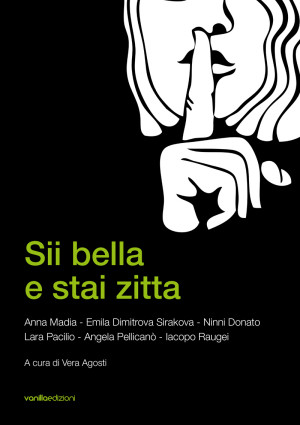Loosely inspired by the wise Be beautiful and shut up. Why Italy today offends women the philosopher Michela Marzano (Mondadori, 2010), with the consent and permission of the author, the collective of the same name presents the views and reflections lyrical contemporary figurative artists of the status of women. The sample, edited by Vera Agosti and promoted by Factory Art Zone, is hosted at the Space Calabria a Milano, from 26 May 7 June 2014, and is sponsored by the Region of Calabria. An ebook and a catalog of Vanilla Editions, made with the generous support of Bank Fineco, document the initiative.
[two_third class=”” last=”no” ]
"Be beautiful and shut up" sounds like a warning of some many moms and grandmothers, that try to explain to her daughters and grandchildren in the streets to be accepted comfortable and well-liked. It 'also the imperative and the forbidden desire of many men who still today for yourself and your dream home a submissive woman, sweet and always beautiful, loved the "angel of the hearth". L’Italia, in fact, even more than other European countries, suffers from a different kind of education for males and females and stereotypes die hard, of which women are the victims and sometimes perpetrators, both these beliefs are rooted in the mentality. So, for example, a woman makes career is often chat or you think that you neglect your family. At the same employment status, the fairer sex earn less than men; in policy are necessary shares rose, and recent senior positions in positions of power entrusted to women were announced as new exceptional and unexpected until a short time ago, instead of being routine. All this while the majority of the burden of domestic work to take care of the house, care for children and elderly relatives almost always falls on the woman, with a little help from the man and the Welfare State. The exceptions only confirm the rule, arousing astonishment and even silly ironies about the "Mummy" and the "home" today.
In mostra, Angela Pellicanò (Reggio Calabria, 1963) and Ninni Donato (Falcon, 1959) explore the feminine universe through intense portraits. Women of Pellicanò, fascinating and dramatic, silhouetted against the red of blood and black pain (Dream Experience, 2011-2014), immobilized by laces, now entered into them (S.t., 2012). They are figures that carry with them the spirit of the lands of the Mediterranean, the thickness of the story and references to the classical world, tying the current all'inscindibile past. The immature girls Ninni Donato, in the foreground, immortalized in black and white shots, incorporated in the resin (Lucia; Teresa, 2012), seem to explain the male component which is also present at the female. The androgyny of the forms and faces makes these young women like guys, as if to signify the common difficulties of growing up in both sexes.
Anna Madia (Turin, 1976) has refined pen and pencil drawings that explore the inner life and the fragility of contemporary. The juice sonnambule (Sleepwalking, 2014) are delicate and dreamlike images, between sleep and wakefulness, in which the long hair, quintessential element of femininity and seduction, collected, loose, or moved to form meaningful compositions (Monologue, 2014) become a symbol of the night, the link between the past and the present.
Iacopo Raugei (Florence, 1975) decreases in its allegories black, painting in minute detail and accuracy a young woman tied to an old TV via the cables of the same, while it is being transmitted to a scene of perfect life, as those to which we are accustomed spot, in which the mother, getting in shape shining, manages to combine perfectly the life work and family, no worries and difficulties (Perfect Lie, 2014). Illusory images of a reality that does not exist, far away from the actual daily, which may, however, be misleading and create anxieties and expectations. In Exit (2008), a woman without a face, in which it is easy to identify himself, port on a silver tray a precious pill, suggested means to escape the pain of his existence.
Emil Dimitrov Sirakov (Sofia, 1984) in its composite drawings on paper sheets (Wall of Breath, 2013; The thousand names, 2012) tells the ancient myth of Kaliakra, North coast della Bulgaria. According to the legend, forty virgins, destined to become slaves Ottoman Emperor, choose to perish in the Black Sea, rather than live the humiliating experience of the harem. For that bind the hair together and holding hands are thrown from the fortress of Kaliakra, annegando. The artist focuses on girls, now fallen into the sea (Hypotermia, 2013): belle, slim and slender like the models of today, folded back on themselves as helpless buds.
Lara Pacilio (Rome, 1978) proposes three installations of the series Carousel (2012). Small rides (Pinkin’ Love, Flying Balloons),made up of symbols of femininity and seductive stereotypes. In The Family Man, the artist touches on the theme of pedophilia, depicting the pedophile as a victim of childhood abuse. The size of the game as a moment of growth and training has been broken at an early age and now the new "game" adult takes on a monstrous. La musica, Our consisting of Luke (guitarist and composer, first electric guitar Parco della Musica Contemporanea Ensemble), accompanies the works on display.
Be beautiful and shut up: Anna Madia – Emil Dimitrov Sirakov – Ninni Donato – Lara Pacilio – Angela Pellicanò – Iacopo Raugei
Under the Patronage of the Calabria Region
Edited by Vera Agosti
Space Calabria – Via Broletto, 14 – Milan (Metro Cordusio)
From 26 May 7 June 2014
Promosso Event Factory Art Zone
Inauguration: Monday 26 May at 18:30
Hours: Tuesday-Saturday: 14-20
Free admission
Ebook e catalogo: Vanillaedizioni
With the contribution of Fineco Bank
[/two_third]
[one_third class=”” last=”yes” ]
VOLUME:
[yit_add_to_cart id=”1076″ attribute_id=”1077″ show_price=”yes” show_cart=”yes” ]
EBOOK:
[yit_add_to_cart id=”1076″ attribute_id=”1078″ show_price=”yes” show_cart=”yes” ]
[/one_third]


